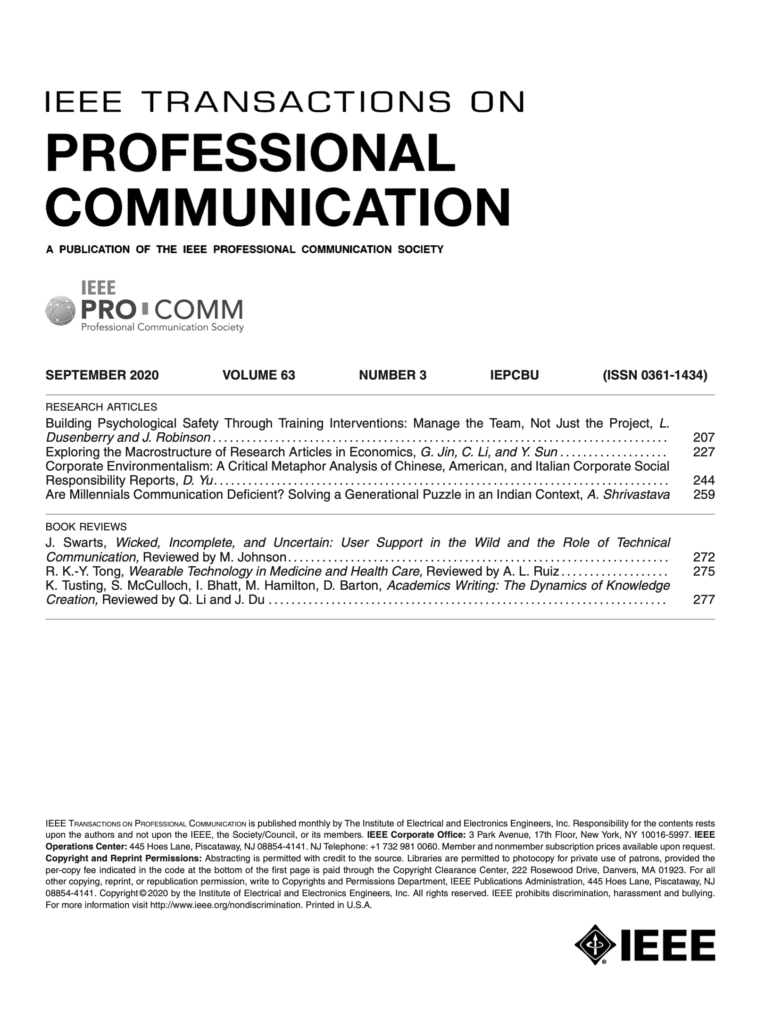The September 2020 of IEEE Transactions on Professional Communication is Now Available
Published on September 15, 2020
The new issue is now available online.

Volume 63, Number 3, September 2020
Publication of the IEEE Professional Communication Society [Publication Information]
Research Articles:
Building Psychological Safety Through Training Interventions: Manage the Team, Not Just the Project, by L. Dusenberry and J. Robinson
Successful team collaborations require psychological safety (PS)—a measure that addresses how individuals perceive their own behaviors in a team, allowing members to be comfortable being themselves. Technical communication curricula do not engage deeply with managing the socio-emotional components of collaboration. A multi-site longitudinal study surveyed 215 students in 50+ short- and long-term teams to understand the effects of a specific training intervention (a PS learning module). Results showed that although training had no significant impact, short-term teams experienced significantly better psychological safety than long-term teams, and psychological safety improved the more time members spent in teams. Comparisons within longitudinal intervals were also significant, indicating that different team contexts influenced the results.
Exploring the Macrostructure of Research Articles in Economics, by G. Jin, C. Li, and Y. Sun
The cognitive load involved in research article (RA) reading can be overwhelming for novice L2 readers. Section headings can be used as signals to help novices focus on essential information related to learning goals to reduce cognitive processing. Examining RA macrostructures can inform RA reading instruction. RAs do not always follow the Introduction-Methods-Results-Discussion (IMRD) model. Previous research has examined the macrostructure of articles in fields such as computer science, applied linguistics, and pure mathematics, but few have investigated the macrostructure of economics RAs. Eighty RAs were collected from five economics journals using stratified random sampling. Their overall structure was analyzed based on section headings and the function and content of each section. Compared with the IMRD model, six new section types were identified: Background, Theoretical Model, Econometric Model, Robustness, Mechanisms, and Application. Interviews explored expert RA readers’ genre knowledge on the newly-identified sections.
Case Studies:Corporate Environmentalism: A Critical Metaphor Analysis of Chinese, American, and Italian Corporate Social Responsibility Reports, by D. Yu
Environmental reporting is an indispensable part of the corporate social responsibility (CSR) report, a main genre of non-financial disclosure for corporations. This study explores how companies use metaphors to construct their role in the relationship with the environment. It investigates 180 CSR reports published by Chinese, US, and Italian companies using the framework of critical metaphor analysis and genre analysis, to approach metaphor use from a cross-cultural perspective. It highlights both universal metaphors (manager, protector, and traveler) and culture-specific metaphors (the bee metaphor in Chinese, the steward metaphor in English, and the fighter metaphor in Italian) across three languages, which are used to represent the company’s good intentions, caring attitude, and responsible behavior, contributing to building an environmentally responsible corporate image. Some metaphors seem useful in inspiring eco-constructive behavior, while others may bear eco-destructive connotations.
Are Millennials Communication Deficient? Solving a Generational Puzzle in an Indian Context, by A. Shrivastava
Although effective communication has been the most important attribute of success in the workplace, poor communication has hindered employees from performing well. This outcome worsens when communication occurs between cross-generational groups in an organization. For this investigation, a 36-item questionnaire measured 12 interpersonal styles through 3 items each on a Likert-type scale. The results presented in this study are not limited to generational stereotyping but rather claim to be accurate and context-sensitive. Indian Millennials defied general stereotypes in several ways. The findings confirmed that although Millennials are different, they are not necessarily communication deficient.

